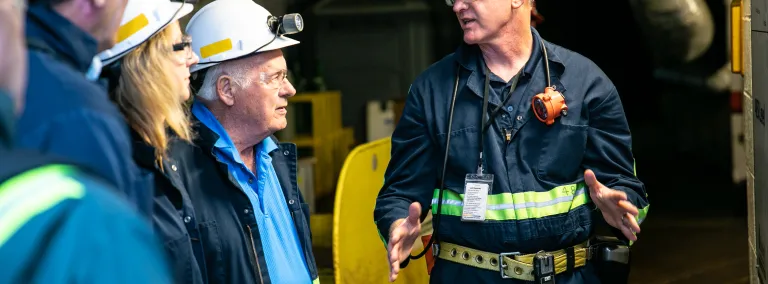"Kid from Brookings” finds world-leading research career in South Dakota
Executive director Headley is proud of the positive impacts SURF has on his home state
As a computer science student at South Dakota State University, Mike Headley had a specific research path in mind: he wanted to study the Earth through the eyes of humankind’s most advanced satellites.
After graduation, he started doing just that. In the U.S. Air Force, Headley worked for six years on complex defense satellite systems orbiting our planet. At the same time, he earned a MBA from Loyola Marymount. Then, Headley began a long stint at EROS, a science center run by the U.S. Geological Survey, where he once again surveyed the Earth through the eyes of satellites orbiting the planet.
Having found this niche, Headley thought he would continue to study the Earth from the skies. But in 2008, he was offered a very different opportunity, a role that would take him out of Earth’s orbit and into a laboratory nearly a mile underground. Headley became the laboratory director for what would become the Sanford Underground Research Facility (SURF). And five years later, he became the executive director of the South Dakota Science and Technology Authority, which manages SURF.
“The Air Force was really a great way for me to start my career, and it became a pathway to becoming the lab director at SURF,” Headley said. “Leading this amazing team, doing this wonderful science, and providing educational opportunities for our kids in the region has been a dream come true and something I truly enjoy.”
Headley had grown up in Brookings, South Dakota. His grandparents, John and Leona Headley, moved to Brookings in the 1950s when his grandfather was tapped to become president of SDSU. Headley was honored to graduate from the same university that his grandfather led from 1952 to 1957.
“Though my grandfather passed away before I was born, my grandmother played a huge role in encouraging education for me and my siblings and in preparing us for the future,” Headley said.
His work in the Air Force took him out of his home state, but Headley always wanted to return. “I love South Dakota,” Headley said. “It's a beautiful state, and it’s so welcoming. And the people are great, they work hard and are so approachable. My family and I love to take in everything the state has to offer, and we're happy to call this place our home.”
Headley said he feels very fortunate to have such a great job in South Dakota. “I had friends who had to move away, because they couldn’t find good jobs in technical fields,” he said. “That’s changing in South Dakota as more businesses move here, and SURF is a big part of that movement.”
SURF has had several impacts on the state—far beyond what was originally envisioned when the facility was established in 2006.
“From a scientific perspective, we are hosting world-leading science with more to come in the future,” Headley said. “We truly are on the world stage within the science community and a leader in science and technology development, and that’s a big deal. But we really need to expand to meet the growing need for additional space for next-generation experiments.”
In late January, a United States particle physics community report emphasized the need for more underground research space in the US. The report highlighted several specific needs for underground experiments: depth, space, material screening capability, access for equipment and people, infrastructure and local support, and underground machine shops. Because SURF meets all of these needs, the US particle physics community “strongly recommended” that new underground space be excavated on the 4850 Level of SURF to house next-generation experiments.
Headley said that expanding the scientific footprint at SURF will also bolster education in South Dakota.
“We are now working with over 20,000 K-12 students yearly, providing programs that are all designed to enhance education and help students think critically,” Headley said. “Additionally, we provide high-quality professional development for more than 500 South Dakota educators every year. All of this enhances an already strong STEM program across the state.”
Over the past 15 years, the State of South Dakota has invested $62 million dollars in SURF, an investment that generated $932 million in federal and private funds. “From an economic perspective, the return on investment for the state has been phenomenal,” Headley said. “In this decade alone, we will have a $2 billion economic impact on the state, resulting in approximately 1,200 jobs statewide and 400 full-time positions at SURF.”
One of the big—and, perhaps, most-asked—questions Headley hears is: “What will come out of the work that being done at SURF, beyond major science papers and basic research?”
Simply put, Headley said, ““This research is helping scientists unlock major questions about how our Universe is put together. The research happening at SURF will be discussed in our children’s science textbooks for generations to come. At the same time, we’re providing great-paying jobs for people here in the state, terrific education opportunities for our kids, and advancing world-leading science and technology.”
And there is even bigger science on the horizon. On the 4850 Level of SURF, excavation is underway to construct and operate the largest particle physics experiment on US soil.
“The future is incredibly bright—for the state’s economy, for K-12 education, and for the global science community,” Headley said. “We’re proud of SURF's positive impact on the state of South Dakota. And, as a kid from Brookings, I’m proud to see this happening in my home state.”
